Electric Cars: Worth the Charge?
This week, we're talking electric cars: we get someone to drive one for a few days to find out how easy the switch to electric might be. And news of the brainy computer that’s made a breakthrough against superbugs, and, on Mars, why the little green men are quaking in their boots...
In this episode

00:55 - AI discovers new antibiotic
AI discovers new antibiotic
Professor James Collins, MIT
While the world races to find drugs and a vaccine to combat the Covid-19 coronavirus, we also face a significant threat from antibiotic resistant bacteria. But this week researchers at the Massachusetts Institute of Technology announced they’ve been using Artificial Intelligence, in other words computers that can kind of “think” for themselves, to dream up new infection-fighting drugs. They’ve used the new system to discover an antibiotic called halicin and it’s proving to be very good at stopping bacterial superbug infections in experimental mice, and could soon be tested on people. The other piece of good news is that this AI system might also help to develop drugs to fight the new coronavirus too. Chris Smith spoke to Jim Collins...
Jim - The issue we set out to solve was antibiotic resistance. We are facing a global crisis: bacterial pathogens, those that cause nasty infections, are growing increasingly resistant to antibiotics, which means they're not responsive to antibiotics, due to the overuse of these drugs. The number of new antibiotics being developed and approved is dramatically dropping, as pharmaceutical companies and biotech companies are getting out of the antibiotics industry. So here at MIT we decided to see if we could harness the power of artificial intelligence, also called AI, in order to address the antibiotic resistance crisis.
Chris - Well, just before we consider how you've done that, Jim, you said something quite interesting, which is that we need a lot of antibiotics, but pharmaceutical companies are deserting this industry like rats off a sinking ship. Why?
Jim - The economics for antibiotics is broken and there are many reasons for it. One is that it costs just as much to develop an antibiotic as it does another drug, for example, say one to treat cancer or to treat blood pressure. Antibiotics, however, are only prescribed for very short periods of time. You take an antibiotic for a few days, maybe a week, whereas you take a blood pressure medicine for the rest of your life. And so the economics for delivery and use are quite low. Second, is that as one comes up with new antibiotics, they're actually not being prescribed out of concern for resistance to arise. So as new antibiotics were being developed and approved, they were being shelved and so companies couldn't even sell their product.
Chris - So how can AI help to address what is an economic disincentive for the pharmaceutical industry to go down this path?
Jim - We wanted to see if we could harness AI to quickly and inexpensively expand our antibiotic arsenal and thereby significantly de-risking what's called the preclinical stage. So the stage of development before you move to human trials, coming up with whole new molecules that could overcome existing resistance and thereby dramatically dropping the economic barriers. So in our project we trained an AI model, so this is a computer based model, with information on existing drugs against E. coli. So E. coli is a bug found in our guts, often harmless to us, but in many cases can be harmful. We've all heard of scares around contaminated meats. In this case we look to see which of these FDA drugs would have some antibacterial activity, so could it inhibit the growth of E. coli or kill it? We took those data, along with the information about each of those drugs, to train this computer-based model to learn molecular features, so features of those molecules that are associated with an antibiotic or being antibacterial.
Chris - So the AI is interrogating the actual physical shape of the molecule. It knows what works against these particular microbes?
Jim - We train it so that it can learn which of the features, even at an atom by atom level, of these chemical compounds appear to be associated with antibacterial activity. We then applied the model to a drug repurposing library that consisted of 6,100 molecules that had been developed as drugs, or were explored as possible drugs, to treat various conditions. And we asked the model to do two things. One was to identify molecules that are predicted to be antibacterial or good antibiotics, but two, to then only identify within that subset, molecules that don't look like our existing antibiotics. And in that drug repurposing library, one molecule fit those criteria and that molecule is what we call HALICIN, which is one of the most powerful antibiotics discovered to date. Its ability to kill a wide range of bacterial pathogens included pathogens that are pan-resistant, that is resistant to effectively all antibiotics; TB, tuberculosis, which has the highest number of deaths as a bacterial pathogen around the world. It was able to kill a pathogen called C. diff, that's a nasty gut pathogen and HALICIN was also able to kill a bug called Acinetobacter baumannii, which is a weird sounding bug, but it's also called the Iraqi bug. The US soldiers and UK soldiers are coming back from service in Iraq and Afghanistan with Acinetobacter baumannii infections, basically in skin wounds, and our existing antibiotics don't treat it well and we showed that HALICIN could actually treat those infections very effectively in skin wound models in mice.
Chris - Now given that the world is currently in the grip of a potential pandemic caused by this coronavirus, is it possible that you could take the technique you've developed and then ask, of the enormous repertoire of drug molecules we already have, could we try some of those and see if we can find a drug that we might not have considered but which might give us an opportunity to intervene with this new pandemic?
Jim - In principle, one could consider using this platform or a related platform to address that challenge. The difficulty in applying it to a viral infection, like the coronavirus, is getting after appropriate data to train the AI model. So what we don't have in many cases are good experimental setups in the lab, that would allow us first to explore which molecules are having an effect. And so for example, in the case of coronavirus, I'm not aware of good cell-based models to get those data. If one had those cell-based experiments that you could generate the data, then then I think this type of platform could become really quite valuable.

07:33 - Tracking coronavirus via bluetooth
Tracking coronavirus via bluetooth
Dr Ramsey Farragher, Focal Point Positioning
While antibiotics work against bacteria, they don’t affect viruses like the new coronavirus, which is steadily spreading around the world. At the moment many countries are adopting a “containment” strategy, where they identify cases and then track down the people they’ve been in contact with to isolate them and stop the spread. But finding out where people have been, and therefore whom they could have infected, is very labour intensive and slow. But computer scientist Ramsey Faragher, from the company Focal Point Positioning, thinks there might be a very quick, simple and extremely cheap way to do this using technology that we already have literally at our fingertips or in our pockets, and he spoke to Chris Smith...
Ramsey - Well, Chris, as you said, it's a very labour intensive process at the moment. When people are announced to have the virus, they're basically asked to write down on a piece of paper all the people they've interacted with for the last two weeks, which is crazy, that we're still doing this in 2020 when our smartphones in our pockets are a brilliant way of storing, gathering, and quickly using all of that information in a much more reliable way than we can do ourselves.
Chris - How does your smartphone know whom you have been rubbing up against though?
Ramsey - So there's a few ways you could use your smartphone solve this problem. The one I'd propose is the Bluetooth connection. One of the radios in our phones is Bluetooth. It's very short range. It's a very low power and for most phones it's on all the time. We use it to use wireless headphones, wireless mice, and to exchange contact details with other people's phones. But it's an aura around our phones all the time. So my phone right now knows that your phone is within the same room as me, because they're talking to each other over Bluetooth. What I would propose is we could store this data in our phones, and if I was infected with COVID-19 we could just ask my phone to give me instantly the list of all of the other phones I've been in contact with for the last two weeks.
Chris - That presupposes though that my phone, when it tells your phone via Bluetooth that it's my phone, that you know who my phone is, and you can come find me.
Ramsey - A system like what I'm proposing would involve the unique IDs of each phone being shared and then encrypted on the device. It wouldn't be the case that you would need to give me your data. It's a simple unique identifier that the phones always share with each other.
Chris - But if you need at the end of the day to identify that you have been in contact with me to have exposed me to this virus let's say, you do ultimately need to know, I've got my phone on me and there are two problems, aren't there? One is that you have to know that I own that phone, so you've got to know how to find me and, you're assuming that I've got the phone, it wasn't that Katie Haylor stole Chris's phone and was on the bus with it and it was actually Katie who's got the contact, not Chris.
Ramsey - Sure. That's certainly a potential issue if people are sharing devices, but I would suspect that you use your phone much more often than Katie does. So the risk of false positives is probably lower than you remembering if you'd met me in the last two weeks.
Chris - How practical is this to implement and how much of a difference could it make if we were to do this?
Ramsey - It's trivial to implement. It's possibly the case that many of the apps in our phones are already doing similar things already. I wouldn't be surprised if social networking apps were already doing this as part of how they work. Every time you use LinkedIn or Facebook, it tries to recommend to you another new friend. It is a mixture of online networks and physical networks that they're using to determine whether you've just met me, and if you should be recommended as a new contact to me.
Chris - Have you put this to anybody who could be in a position to implement this?
Ramsey - I have not, but maybe we should Chris.
Chris - Yeah, well I'm thinking you should. I just wondered what sort of a reaction you get, do people worry about the fact that all of a sudden, this could be regarded as another means of cyber surveillance or are people generally supportive? They could see the merit in this because you could potentially know exactly who you've been in contact with and to do contact tracing in situations like this.
Ramsey - I have no doubt that something like this could save a lot of lives if it was implemented. There are issues of it being misused, but that's the case with anything like this. As long as it's used for the reasons it's being put in place for, then it's used in the right way.

Quakes on Mars
Professor David Rothery, Open University
We’re shooting off to Mars, because there’s news out this week that the red planet is seismically active and it experiences marsquakes. Katie Haylor has this report...
Katie - NASA's insight mission is tasked with finding out what's going on inside the red planet. In November 2018 the static lander arrived on the surface, and got to work. Now, the publication of several papers worth of data are revealing its findings so far, and the Open University's planetary geoscientist David Rothery gave me the lowdown.
David - Well, in 10 months there have been not far short of 200 separate Marsquakes, and most of them are small events and they appear to be vibrations that travel just through the crust, that's the outermost rocky layer of the planet. And they're not very well understood. But there have been 24 recorded that measure magnitude 3 to magnitude 4 on the Richter scale, which have caused vibrations, which had been strong enough to travel through the crust into the mantle and then back out of the surface where the detector is.
Katie - These Marsquakes are detected by Insights' seismometer sitting on Mars' surface: it is essentially a very sensitive microphone that records the planet's vibrations.
David - They can pinpoint the source of some of these earthquakes. At least two of these appear to be in a region about a thousand kilometres from the Lambda Kerberos fault side. This is where the surface is quite badly fractured, some quite deep chasms there, where people had previously suggested there were earthquakes. So you can see where boulders have tumbled down slopes and bounced through recent sand dunes. So something recently disturbing the ground. Could that be earthquakes? Well now it seems that inference was right because Marsquakes have been pinpointed back to that very region.
Katie - So what's actually causing these Marsquakes?
David - Well, these Marsquakes are not like the big earthquakes we get on the earth, which are at the boundaries between moving plates. Mars's crust and upper mantle is not divided into rigid plates sliding around on a plastic interior like we have on the earth. The quakes on Mars are like what happens inside Earth's continents where stresses just cause some fracturing or some buckling or something like that. So they're relatively small. They're like the biggest quakes that we occasionally get in the UK. But Mars's crust, a rigid outer layer, is under stress, and now and then the stress overcomes the strength of the rock and the rock fractures. And that's a Marsquake.
Katie - Now that we know for sure that Mars is indeed quaking. How does this help us better understand the geology of our planetary neighbour?
David - We'd like a few more quakes before we extrapolate too wildly. But we do know, number one: Mars is active today. Quakes are definitely happening. Previously we inferred them, now we've seen them. It's likely that part of the mantle is mushy because the shaking wave, so-called S waves, do not travel very well at all through part of a mantle. Whereas the compressional waves do travel quite well. So we're beginning to understand the mechanics of inside Mars.
Katie - Looking ahead, could these findings have any impact on, perhaps one day, a base on Mars?
David - What we're learning about the properties of the shallow crust will help because we want to know what we're building on. But some people have been saying on social media: "Oh there are Marsquakes, it's too dangerous to go and put bases there". That's completely untrue. You wouldn't refuse to build a base in the UK because there's occasionally a magnitude 3 earthquake here, or in the middle of Siberia because there's a magnitude 3 earthquake every so often. Mars is perfectly safe seismically. You wouldn't build a base in the bottom of one of the chasms on Kerberos Fossi, because you've got a great big cliff above you and a boulder could fall off if dislodged by a Marsquake. That's common sense. We're not learning from this that we shouldn't go to Mars because Marsquakes occur. We're understanding about the interior of the planet from what Marsquakes can tell us.
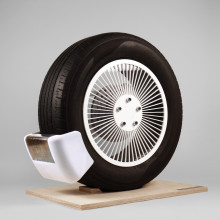
17:32 - Capturing tyre pollution
Capturing tyre pollution
Hanson Cheng, Imperial College London and The Royal College of Art
Hear the phrase “vehicle emissions”, and you might instantly think of the exhaust. But tyre-wear accounts for nearly half of road transport air particulate emissions, and a student group at Imperial College London and the Royal College of Art have announced this week that they’ve made a device to capture bits of tyre that come off of cars, trucks and lorries during use. Chris Smith spoke to Masters student Hanson Cheng...
Hanson - Yeah, so there's actually half a million tons produced in Europe annually.
Chris - Just in Europe. So when you add to the rest of the rest of the world, it's going to be huge amount.
Hanson - It adds up. Tyre wear is actually the second largest microplastic pollutant after single use. Plastics and tyres wear off every time we accelerate, brake and turn a corner. And the particles are actually small enough to become airborne, which are linked to lung diseases, and the ones that make it into the waterways affect marine life as well as enter our food chain. While electric cars are great, and developments in renewable energy tailpipe emissions are projected to fall quite significantly, tyre wear will increase because of the heavier battery and torque of the car.
Chris - Yeah, that's a very good point. So basically, you know, as we move towards an electrified future, while we're dealing with one form of pollution, actually there's one very important one that's still there, like the elephant in the room and that is the wear particles of tyres. Have you got a solution that will work then?
Hanson - So we discovered that particles coming off tyres are charged due to friction with the road. So we created a device that captures particles using electrostatics, collecting them at source and preventing them from even entering our environment.
Chris - Why are they charged?
Hanson - From friction with the road surface.
Chris - So it's rather like rubbing a balloon on your head and then sticking it on the wall? You get some static electricity, the particles flying off the back of the tyre are charged in the same way.
Hanson - Yeah. So that's actually one of our first experiments. We took a sandpaper to a wheel, rubbed the balloon and saw that the particles jumped up and down. And so we built a test rig to test our initial idea and we explored different ways and geometries to maximize surface area to collect the particles. And we're currently at about 60% efficient.
Chris - Is this a bit like, you know how you have a mudguard on the back of the car that sort of dangles down and is there to cut down spray? Does it work in the same sort of way that you've got your trap deployed on that so that as the particles come up they have passing over that and it's charged and can attract them rather like iron filings are attracted to a magnet?
Hanson - Yeah. So our current device is attached on a wheel, and harnesses the spin at the wheel as well as its position, to take, and account for all the air flows around the wheel, to direct the particles into our device, and then electrostatics works to capture them.
Chris - And how effective is it? Do you know roughly what proportion of the particles that would otherwise end up in my lungs get caught?
Hanson - Currently in our test rig, we are capturing 60% of all airborne particles tested over one hour intervals, but the next steps would be to put our device on a car and see how it performs.
Chris - Why is it only 60%? I don't mean that in a disparaging way - 60% a lot better than nought percent, but why is there that 40% missing?
Hanson - A lot of that is just because of the position of the device. It needs to be as close as possible to the contact patch, but then you also have to be wary of hitting speed bumps and such, so we'll have to position further away than we want to.
Chris - And how does it hold onto the particles? Once it's got them in the first place, how do you make sure they don't fall off again?
Hanson - So once they're collected on the plates, we're using various cleaning mechanisms to gather them in a storage unit and then once they're in a storage unit that can be removed. These particles are actually small enough that they could be reused. So once we collect it, we can actually use it back into the manufacturing process of tyres as well as different applications or more creative applications such as extracting them for dyes and 3D printing.
Chris - What's the energy cost of doing this though? Is it going to add a lot of, effectively, miles to the gallon to a car if you were to deploy this?
Hanson - That is something that we're currently looking at. We're at the proof of concept stage and in our next prototypes we will consider more cost effective ways to develop a device that's more integrated.
Chris - And could you retrofit this? I know that you've got the electric car market in mind, but existing vehicles are a major headache with this. Could you retrofit to the existing road stock?
Hanson - Yeah, so we're looking into retrofitting them on buses just because they produce more per kilometre, basically from their weight, and they have a regular maintenance schedule that we could tap into to remove the cartridge and send it back to us.

22:13 - Katherine Johnson - NASA mathematical legend
Katherine Johnson - NASA mathematical legend
We were saddened to hear of the recent death of NASA’s mathematical legend, Katherine Johnson. It was her calculations that got men to the moon, and safely home again. Indeed, some astronauts refused to fly unless she’d personally looked at the figures. Adam Murphy has been reflecting on her contribution to the space race…
Adam - Katherine Johnson, legendary NASA mathematician, passed away on February 24th at the age of 101. Johnson was renowned for her mathematical abilities. She began work at NASA’s predecessor, the National Advisory Committee for Aeronautics, where she was a human computer, reading the black box data from aeroplanes. She spent her time there segregated by both her race, and her gender. Eventually, it was impossible to ignore her mathematical skill and she began assisting with NASA spaceflights, although she still faced pervasive discrimination. She calculated the trajectories rockets needed to be launched at, and even the times at which it was possible to launch them at all. Overcoming the barriers faced by black women in the sciences, Johnson’s work is part of so many iconic moments in NASA’s history. Johnson calculated the trajectory for the rocket, and the launch window for Alan Sheppard’s 1961 mission that made him the first American in space. When electronic computers began to be used at NASA, astronaut John Glenn refused to accept the figures until they had been checked by Johnson, stating “If she says the numbers are good, I’m ready to go”. Johnson was involved in the first mission that put men on the moon, helping to calculate their launch trajectory. And when Apollo 13 announced that “Houston, we have a problem”, Johnson’s work on backup procedures helped to get them home safely. Johnson’s contributions to the history of space travel went relatively unrecognised for decades, but in 2015 she was awarded the Presidential Medal of Freedom by Barack Obama, the highest civilian honour the United States gives. And she and her colleagues were also the focus of the 2016 film Hidden Figures. A fitting honour for someone who’s work has impacted so much of modern science.

24:53 - Mailbox: feedback on beavers
Mailbox: feedback on beavers
Katie Haylor and Chris Smith open up the Naked Scientists mailbag to see what you've been sending in...
Chris - Now we heard from John last week, he got in touch about the piece on beavers. He says, and just for context, we were explaining that there is a project to add beavers back into the wild following their extinction about 400 years ago in the UK, because they're regarded as important ecosystem engineers and therefore might be able to help us mitigate some of the flood risk in the flooding that we've been having in the UK recently.
John says "where I live, we have lots of beavers. They plug up culverts because they don't like the sound of running water. They create large dams, eat the local vegetation and then move on. A few years later the dams burst and then they wash out roads. My picture of reality is very different from the one I heard on the programme. I'm sure they are good in some senses but what was said was not even handed." So John obviously not a fan of beavers.
Katie - And if you want to get in touch with any comments or questions you've got about the show, you can do so via email. It's chris@thenakedscientist.com, we always like hearing your thoughts and feedback and also if you'd like to leave us a review, you can do so wherever you get your podcasts.
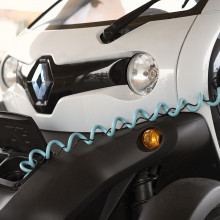
27:41 - How electric car batteries work
How electric car batteries work
Dr David Hall, Cambridge University
What’s actually powering the average electric car? Chemist David Hall works on battery technology at the University of Cambridge, and Chris Smith and Katie Haylor asked him for the lowdown on batteries...
David - Every battery, whether it's a lead acid in your petroleum based vehicle, whether it's a watch battery, or your cell phone's lithium-ion battery, it always has two electrodes. They're solid pieces of material, and they're separated by an electrolyte that's made up of a salt and some sort of a solvent. So lead-acid uses acid dissolved in water. Lithium-ion uses a lithium salt dissolved in an organic solvent, which is carbon based.
Chris - How does it actually make electricity?
David - Batteries use the principle of electrochemistry, where we can convert between chemical energy, and electricity. And we do this by passing current through a wire outside, and then there's a current inside the battery that flows through that electrolyte. That's the movement of those charged particles in the salt.
Chris - So when a battery is charged up versus discharged, what's the chemical difference?
David - So in the case of a lithium-ion battery, basically we take lithium from one material on the positive, and we move it into the layers of the material on the negative side. And that's a very unstable, high energy arrangement, and it wants to get back to how it was before.
Chris - When it's in that unstable state, it's charged?
David - Exactly.
Chris - And when it flows sort of, down the energy hill as it were, to get back to the other material where it's more comfortable, it's discharged?
David - Correct. Exactly.
Chris - So that's why it wants to push electricity around the circuit, because to make that journey, the lithium has got to surrender some charge around the circuit first?
David - Exactly. And it's a much more controlled way to release energy than say, burning fuel, which just releases heat uncontrollably basically.
Chris - And the cars that are being put on the roads that are electric vehicles, do they just use the same technology, the same lithium batteries effectively, that are in my mobile phone?
David - They're very similar in many ways. What's different is the exact components or composition of those materials, especially the positive electrode material. So a lot of phones will have cobalt, whereas modern batteries will have cobalt, nickel, manganese, aluminium in some combination.
Katie - David talking of phones, my mobile phone battery is, ugh, it's really in need of replacement. Why do batteries degrade over time?
David - As you're using your battery, ideally all of these changes, moving lithium from one side to the other is completely reversible, but unfortunately there are these side reactions. You can think of it like how your car rusts with time. It just slowly degrades those materials, and they break down. And you also slowly degrade that organic solvent that I mentioned, releasing gases and oxygen and that sort of thing.
Katie - Can you then tweak the chemistry to try and fix that problem?
David - Absolutely, and this is a huge area of research in the UK and around the world, to understand what exactly is causing those different degradation, parasitic reactions. How can you slow them, or control them, or even just predict them reliably.
Katie - What about habits though? Bad charging habits for batteries. I'm thinking of phones, but I guess with electric cars it must be a similar sort of thing, right?
David - Certainly for phones and laptops, the best thing you can do is make sure they don't get too hot. So don't leave it running full power in your shag carpeting, where it gets really, really hot. Heat is the main thing.
Chris - The guy who invented lithium batteries got the Nobel prize, didn't he? Why are we still married to lithium though, David? Why have we not found an even better chemical or a better way of doing this? Because people say to me, although lithium batteries have made a sort of revolution in storable energy, they're still not without their constraints. As Katie says, her phones clapping out, my laptop will only run for 10 minutes now compared to what used to be five hours.
David - The main concept of lithium ion batteries really hasn't changed. Take lithium out of one side, put it into the negative electrode on the other, but those materials are significantly different than the original ones that got that prize. So modern battery chemistry is actually very different, and you can hold something like two or three times as much energy in the same space. So there is a lot of progress, even within lithium-ion.
Katie - We mentioned charging habits. I'm just curious if you have any advice for charging habits when it comes to an electric vehicle, in terms of the battery?
David - that's a huge area of research as well, that I've spent many years thinking about, especially how can I charge a vehicle very quickly. And usually the faster you charge it, the more damaging and more destructive it is on it. So you try to make things more conductive, so that ions and electricity can flow more quickly and more easily. And that's really a design aspect for where we think these vehicles will be used, how we think they'll be used.
Chris - So it's just a question really then, of not abusing your battery. Is there technology built into batteries to stop us abusing them?
David - Absolutely, and it's a huge area in engineering to build what we call battery management systems, that regulate the temperature, that try not to pass too much current into one battery too quickly. It's another area of development that the auto makers are really getting better at.
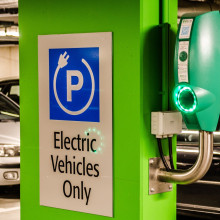
32:49 - Vehicle to grid charging
Vehicle to grid charging
Claire Miller, Octopus Electric Vehicles
Apart from the potential to avoid pollution - and power a vehicle with renewable energy - electric vehicles also offer another advantage: when the vehicle is standing idle, which most cars do most of the time, the batteries that supply them are also ideally suited to powering the national grid. And that’s where companies like Octopus have seen a gap in the market: the idea is quite simple - your car gets charged with surplus electricity when energy is cheap and readily available. Then, when the tables are turned and the grid needs a helping hand, your car sells some of its stored energy back to support the supply. But first, you need to plug it in! Here, Megan McGregor gets to grips with charging an electric car, then you'll hear from Claire Miller and Katie Haylor...
Megan - We've just opened the, I want to say petrol cap, electricity cap? And there's two sockets inside. One's got an orange cap on top, that I'm just going to open. This is on the front of the car, not the side of the car, like the petrol cap. So now I have the cable and one end goes into the car. Presumably the other end goes into the charger. And now I have the RFID tag, which just looks like a loyalty points card, for example. And I scan that on the thing. And now the blue lights on the dashboard are flashing and the car is charging. And so if I wanted to do, I could go about my business now. And it's as simple as that.
Katie - Megan was plugging in at the Madingley Park and Ride there, in Cambridge, but charging the car at home can unlock some interesting opportunities. It's possible for electric vehicles to put electricity back onto the grid via a process known creatively as, vehicle-to-grid. Claire Miller, director of technology and innovation at Octopus Electric Vehicles, laid out what you need to make this work.
Claire - You need a car which is suitably enabled. Nissan Leaf is one of the very few vehicles that can do that. And a special charger, which can take the energy back from the car as well as to put it into the car. When you plug your car in around five, six, seven o'clock at night, you'd see the car start to put energy back onto the grid. And that's because at that time of night, everyone comes home, wants to make their tea, put on the television, use a lot of electricity. And so that's a good time for your car to be able to give some electricity back to the grid.
And then overnight in the small hours of the morning, when electricity is cheap on the grid, and often there's a lot of it available, particularly as we have more renewables becoming available. So for example, on a windy night, there's lots of electricity on the grid that needs to go somewhere. You would see your car start to charge up.
Katie - We know that over time lots of charging and discharging can lead to battery degradation. Just look at what happens to your phone battery life. So what does the added charge and discharge of vehicle-to-grid do to your car battery life? Well, turns out not all battery cycles are created equally.
Claire - Early studies are showing that the way that a vehicle-to-grid cycle works for the car battery, is actually a really safe way to charge and discharge the battery. If you imagine when you're doing a vehicle-to-grid cycle, you plug the car in. The way that the energy is removed from the battery. We've done a lot of work to make sure that our, we call them battery profiles, is done in a very smooth way.
If you compare that with the way that we drive our electric vehicles, we might be driving in town, stop, start, accelerating, braking, and then out onto the motorway, so driving fast, and then slowing down again for traffic. That's a much more uncontrolled way of using our battery. Discharging the battery, using energy from the battery, to put it back onto the grid is a much smoother way of using energy.
Katie - The jury is still out on the longterm effects of vehicle-to-grid on battery life. Some studies suggest it might improve long term battery life, while others have suggested neutral or negative outcomes. It all seems to depend on how much battery degradation happens while the car is at a standstill. However, the advantages of vehicle-to-grid extend beyond a potential increase in electric vehicle battery life, it could help improve the resilience of our electricity grid.
Claire - So the advantages for the grid, when there's that spike in demand at tea time, it gives access to sources of energy beyond say burning gas, which in the UK we do to meet that demand very quickly. So it really helps to balance the grid. And what that means is that lots of people are demanding or asking to use electricity, and so the grid has to get it from somewhere.
Katie - If that's somewhere is going to be electric car batteries, some pretty sophisticated management software is required. For one user, it can be a smart meter or a phone app, but for a whole fleet of vehicles, software that can coordinate charging and discharging will be needed. Vehicle-to-grid advocates see this technology as part of a new approach to home energy management, where the car is just one part of a larger system that gives consumers much finer control over their energy usage.
Claire - Vehicle-to-grid is just one way in which we'll be able to control and decide where we use energy, and where we put energy in the future. If you imagine a home which has solar panels on the roof, and maybe a static battery in the garage, for example. Maybe you've got a Nissan Leaf as well. We're looking at developing systems where you'll be able to choose. Do I charge my car with energy from the grid for example, because it's nighttime, there's lots of wind, so it's green energy on the grid and it's very, very cheap. So you might choose to charge your car from the grid, and you might charge to top up your home battery from the grid as well. Another time it might be tea time, for example, tea time, peak demand, and you might choose to actually put energy from your car and/or your battery back on the grid, because you know that the grid needs the energy and you might get paid for it.
So we are absolutely looking at ways of helping people to control and decide where they use energy, how they store it at home, most people don't have a way of storing energy at the moment, and making those decisions. So both on a financial perspective, will I get paid for it, and will it be cheap for me? And also, is it a green way of charging my car, or can I help the grid by avoiding burning fossil fuels?
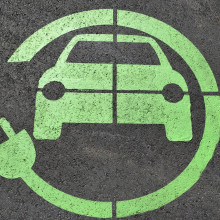
40:38 - Storing green energy
Storing green energy
Dr Kathryn Toghill, Lancaster University
A lot of electric cars have “zero emissions” emblazoned on the side. But they’re only as green as the energy used to charge them. Renewable energy is becoming more available, but not necessarily “on tap” 24/7. For instance, the sun doesn’t shine at night! Kathryn Toghill, from the University of Lancaster, works on one potential solution to this problem, as she explained to Chris Smith and Katie Haylor...
Kathryn - Renewable electricity has been penetrating the market at a significant rate over the last few years. We use a third of it, it's this intermittent energy. So we need some kind of mediator between the energy generation and the use on the grid to actually balance that out. And that's where these batteries come in.
Chris - Is it as simple as the kinds of batteries one puts in a torch, you just have loads and loads of those, and you put them near your wind farm or you put them near your solar array, or even in your house, and you just basically use them like an energy sponge, they soak up any surplus when you don't need it? Is that basically the concept?
Kathryn - That is basically the concept, yes.
Chris - So what's not to like?
Kathryn - The cost of the system is the issue. So the problem with the batteries we've made for these portable technologies like for electric vehicles or for your phone, anything like that, is that they're designed for high power, high usage, they're designed to be lightweight, they're designed for a completely different profile of energy use. Whereas these stationary energy systems, they need to take on large amounts of energy, they need to scale up on a considerably higher scale than your portable systems, and they need to deliver that energy in a smoother way as well.
Chris - I suppose that a weight, when you're talking about a stationary battery that's just parked on a site or even in your utility room, is less of an issue than it is for an electric vehicle where the battery's got to be a certain weight, a minimum, and presumably also got to fit certain specifications because it's got to be a certain size and fit into a certain space in the car. You're less constrained with a domestic or a wind farm system.
Kathryn - Absolutely. Yes, so you've now got a completely different area of chemistry to be exploring because you're not so constrained anymore. The other issue is that what we really want from a stationary storage system is something that has longevity. So now lifetime really matters and the depth of your cycling really matters. So whereas earlier you were talking about your batteries dying very quickly in your phone or in your laptop - we can't have that happening in stationary storage. So that's where the alternatives to what we already have are coming in. That's where new chemistry is being designed.
Chris - Now when you say new chemistry; in other words, we're not just going to take the batteries that work in an electric car and just basically repackage them for domestic use? You could do that, but actually you're saying you could do it better.
Kathryn - Yeah, there'd be no advantage to that. First of all there's going to be high demand for lithium ion, so lithium is not that sustainable if every kind of technology is going to be using it; so where we can switch to a different chemistry, that's a better idea generally. The alternative chemistries we can be using will have a different design entirely as well. So we don't need that high power, we don't need that fast charge capability, so we can start looking at things like flow batteries where you're working with completely different metals and a completely different system design as well.
Chris - So what's a flow battery then?
Kathryn - So a redox flow battery is where all your charge goes into the solution; so where we talked about electrodes and then an electrolyte in between them earlier in normal batteries, your electrodes are what matter and that's where all the charge is kept; but in a flow battery it's all kept in the electrolytes. So you have these chemicals in solution that can take on charge and they can give back charge depending on which way you want your flow to go in your battery. And then you store these solutions in big tanks so they're separate from the electrodes. And that means you can scale up your tanks depending on how much storage you need, or you can scale up the number of electrodes in the middle depending on how much power you need.
Katie - Kathryn, you mentioned that the electrolyte is the important thing here. So what's novel in this area then?
Kathryn - What we use here that's the state of the art is vanadium. So vanadium ions in solution, nothing is solid in there. They are charging and discharging, different states, depending on what you need. But also we are moving away from metal-centred flow batteries as well. So we're trying to look at technologies where we don't have metals in there at all bcause they have two political issues associated with them.
Chris - Kathryn, if I may: if you've got a battery system that's built around a liquid, you're saying the electrolyte is the charged thing and the electrodes are less important, that sounds to me very much like the petrol that we put in a car tank. So have we not got a really nice solution here which uses much of the infrastructure we already have for dispensing an energy-rich fuel into a car? You could just fill up your car battery with a charged electrolyte, and then when the charge has been used up you drain that depleted electrolyte out and replace it with some replete, charged electrolyte again.
Kathryn - It is not a crazy idea actually. But unfortunately vanadium flow batteries and most flow batteries, the energy density is too low. So you're looking at something that's ten times less dense in energy than a lithium ion battery. So it wouldn't be feasible because petrol has a very high energy density, even though the system is quite inefficient. But there are people researching... so up in Glasgow, for example, there are people who have been researching these new materials which would deliver very high energy density# liquid electrolytes. So that could be an option in the future. But it's quite far away at the moment.
Chris - And what about price, Kathryn? Because I've been talking to some people who live in, for instance, remote parts of Australia. They're very reliant on solar, for example. And so for them, the ability to store a lot of charge in a decent battery, it can be a life-changing thing. But how much does it cost to install a rig for say a domestic setup?
Kathryn - It depends on the rig you have, but you're looking at installing it coupled with solar, that would influence the cost as well. And then you've got your battery management system. So there's lots of different components, it's not all dependent on the battery itself. But you're looking at tens of thousands of pounds for a home storage system.
Chris - Pretty pricey then.
Kathryn - But it's equivalent to an electric vehicle.
Chris - But then I suppose if you've got the electric car parked in the garage and the stationary battery in the utility room, are we getting to the point where everyone's basically got their own power station at home? Is this not overkill?
Kathryn - I don't... I personally wouldn't want to cycle my car battery because that battery is not designed to do many cycles. I would want that load of a long lifetime for a home battery storage system to be on something that's designed for that purpose.
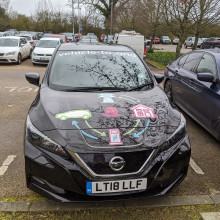
47:24 - Paying for charge
Paying for charge
Elspeth Brown, Octopus Electric Vehicles
If you plug the car in at home, it’s your domestic bill that gets charged. But what worries prospective electric motorists the most is what about if you need to charge up while you’re out and about? Well this is, at the moment, one of the big weaknesses in the system. Although there are potentially lots of charging points, as Elspeth Brown explains to Megan McGregor, there are lots of players in the market and you need to be signed up with several of them to charge your vehicle...
Elspeth - We have used BP Chargemaster Polar today. This is one of the options for public charging across the UK with a per pence kWh. On the motorways there's the Ecotricity; Ionity networks; there's the Tesla Supercharger network; there's hundreds of people getting into the public charging space. A lot of them are only available perhaps on the motorway; so I have on my normal keys about four or five of these different fobs, plus a few apps on my phone. It is becoming difficult and they're all different price per kilowatts, and it's all ever so slightly different. We're trying to create a solution, which is a roaming card that will reduce it all onto one card, or as many networks that want to work with us, and then it will come on to either your Octopus energy bill or take it off your card.

48:44 - Recycling EV batteries
Recycling EV batteries
Dr Gavin Harper, Birmingham University
How can the batteries inside electric cars be recycled, once they reach end of life? We need to plan for this, because the industry will struggle to continue to source the materials needed to make new cars and batteries if we haven’t got a way to supplement supplies of raw materials. Megan McGregor spoke to Birmingham University’s Gavin Harper about the way forward...
Gavin - If you take a battery and you were able to slice it apart very carefully without contaminating the materials in the battery, and if you were able to scrape off the cathode material from the electrode, and then you might apply some processes to improve its quality, and then coat that material straight into a new battery, that is direct recycling. And the benefit of that process is that it's not just about recovering the raw materials that go into the battery, it's also about preserving the structure in the cathode materials. And obviously a lot of energy, a lot of effort, goes into creating that structure of the cathode material.
Megan - It seems to me to assume that the battery chemistry will stay fairly constant. Are the recycling possibilities if down the line the battery chemistry changes? So for example, the amount of a material that's required goes up or down?
Gavin - I think the main challenge at the moment is around cobalt. Batteries with high cobalt content are very energy dense, which is good from the perspective that it gives the electric vehicles a really good range. The challenges around sourcing cobalt mean that there's a real push to try and reduce its use in electric vehicle batteries. Cobalt largely comes from the Democratic Republic of Congo. The conditions in which it's mined would cause a lot of concern. Children that are working in mining and the sort of unregulated industry that runs alongside of the sort of mainstream mining industry. There's work that's ongoing at the moment to look at, first of all, if you've got for example, a range of different cobalt chemistries and you've mixed everything together, how can you segregate those different cathode materials in a direct recycling process? So that is step one. And then secondly, there's work ongoing to look at if you've got chemistry of one cobalt formulation, can you reformulate that into a different battery chemistry by adjusting the mix? And I think they're both really interesting avenues of exploration for direct recycling.
Megan - And is it possible in future that if we manage to reduce the cobalt concentration in future batteries, that it may become desirable to recycle the batteries of today more immediately, because of their high cobalt concentrations?
Gavin - Yeah. So I think there's a real tension between recycling and reuse. And if we think about how the market for recycled batteries might operate, if a battery comes out of a car and it's still got useful life in it, then that has an economic value. And so our normal approach would be to reuse that battery and extract the most life out of it, you know, squeeze the pips out of it as it were. However, you could imagine a situation in the future where the supply of cobalt was constrained, either because of the supply chain or processing capability or the mining. And in that situation it might be advantageous to recycle batteries early that are of a high cobalt chemistry. If you had a technique whereby you could produce more batteries with a lower cobalt chemistry from the same resource, I think you can look at what's optimum from a resource allocation and resource efficiency angle. But then that's obviously going to run into the buffer of real world economics.
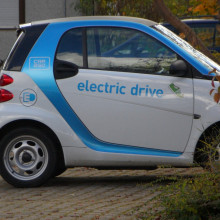
Megan's verdict on electric cars
Megan McGregor, Naked Scientists
The show began this week by handing the keys of an electric car to Megan McGregor, who normally drives a standard petrol car. So what’s her verdict?
Megan - After a weekend using an electric car, what do I think? Well, first off, I think a lot of the concerns about range haven't really kept up with reality. I had no issue while I was pottering around this weekend and unless you're driving 60 miles each way to work everyday, I wouldn't foresee any problems for day to day use. I still have a bit of lingering concern about charging. I was able to make do with the charging point at the park and ride this weekend, but I honestly wouldn't want that to be a long term solution.
All the different charging networks give you choice but it feels pretty overwhelming for a newcomer. From the people I've spoken to for this show, it seems everything is a lot more manageable if you can get a home charger installed, but I'm not in a position to do that. That said, if you can get a home charger, I think you're onto a winner and I do hope that public charging infrastructure develops to a point where not being able to charge at home doesn't feel like a barrier to owning one of these cars.

54:16 - QotW: Are big dogs cleverer than small ones?
QotW: Are big dogs cleverer than small ones?
John - Dogs come in all sizes, from tiny Chihuahuas to giant Great Danes. Their head size is hugely different, as must be their brain size. Does this mean that a Great Dane is massively more intelligent than a Chihuahua?
Mel - Dogs are indeed one of the most morphologically diverse mammals on the planet, with the smallest dogs weighing up to 17 times less than the largest dogs. This means that some dogs can have a brain twice as big as other dogs.
We put this question on the forum and twitter. Alan Calverd made the point that we also need to define intelligence in a dog. To answer this, we approached biological anthropologist Daniel Horshcler, from the University of Arizona, published a study last year that looked at brain size specifically in dogs.
Daniel - We studied over 7000 dogs from 74 different breeds, and found that breeds with larger brains do have better cognitive skills, that can help animal control their behaviour. Dogs with bigger brains have better self-control – after being forbidden from taking a treat, they were able to wait longer before giving in to the temptation of stealing it, even after controlling for their training history. Larger-brained breeds also have better short-term memory, as they were better at remembering the location of hidden food, after delays ranging from one to two and a half minutes.
Mel - Although big brained dogs were more skilled in some areas, they were not better at physical reasoning, or understanding social cues, like responding to pointing gestures.
Daniel - While it appears that differences in brain size could make larger dogs more skilled in some areas, it’s not fair to say that they are massively more intelligent than their smaller counterparts.
Mel - So what makes brains more intelligent? I spoke to Tim Rittman, a neurologist at Cambridge University, to wrap my brain around it.
Tim - There are a number of factors that make brains more intelligent. Size helps, but it isn't everything. As the brain has developed through evolution, the most recent addition has been the frontal lobe. This handles parts of behaviour and planning, so-called executive functions.
One way to make the brain more efficient is to have folds, which is why the human brain looks so wrinkly, but a hedgehog or a mouse brain is smooth. These folds help shorten the distances between any two brain regions, making the brain more efficient. So, ultimately how intelligent your dog is depends partly on size for some brain functions, but also on balancing the cost of brain connections, or wiring, against having an efficiently organised brain.
Mel - Thanks to Tim and Daniel for their answers. Next week it’s Steve’s question about fusion.
Steve - With the advent of fusion power apparently only being 20 years away and the construction of commercial prototypes to start soon. How much do we expect to get out of this energy wise for what we put in, is it twice as much out or 1000 times as much out? And is it also true that nobody has managed to get out more than they’ve put in to date?










Comments
Add a comment